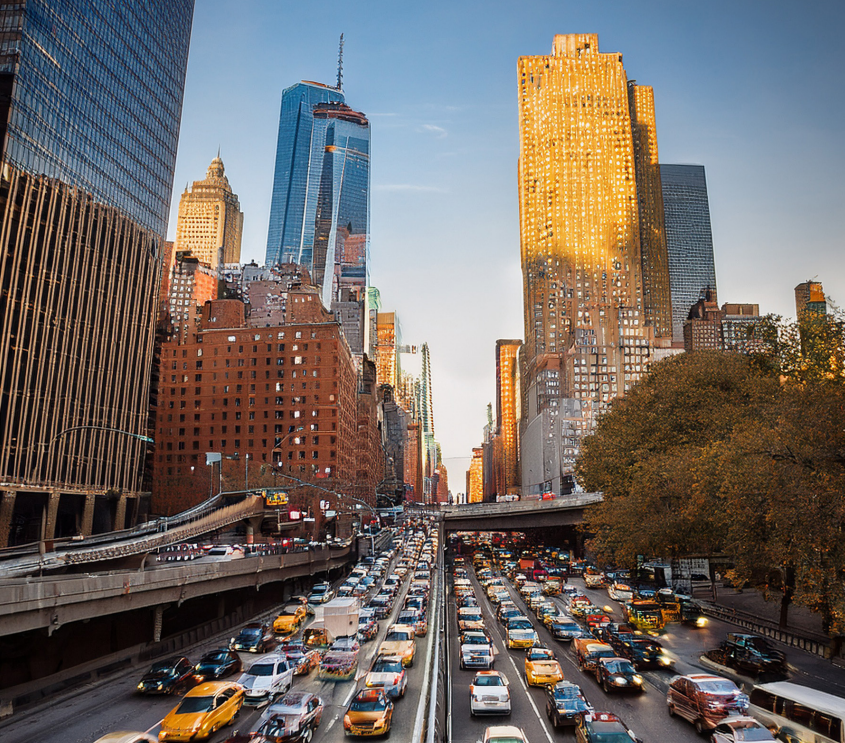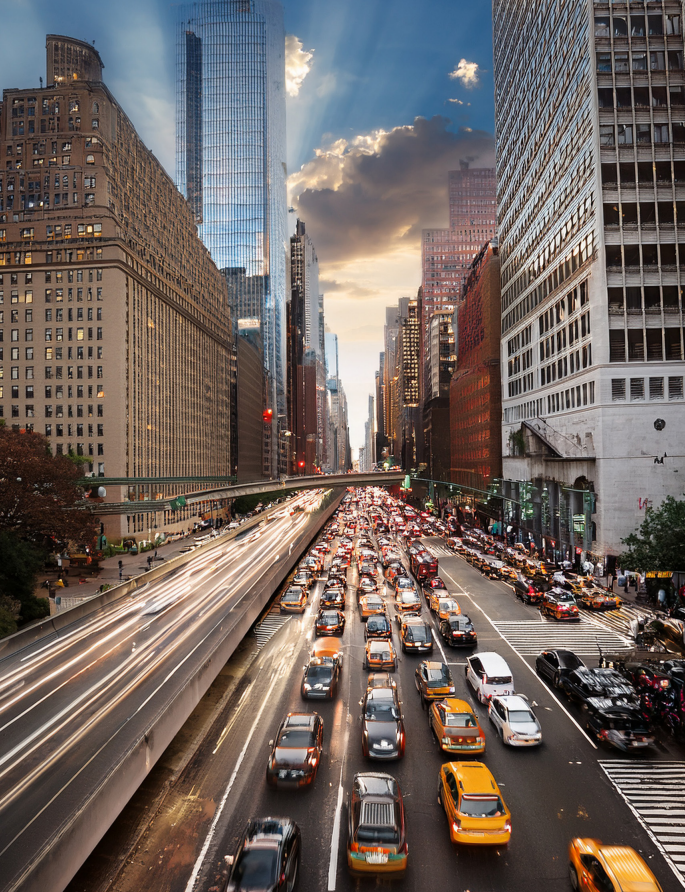From Rush Hour to Remote Work
How Hybrid Schedules Are Transforming Urban Traffic in 2025
By Hafsa Saim
A typical morning in any major city paints a familiar picture: endless lines of vehicles, blaring horns, and exasperated commuters inching their way to the office. Traffic congestion remains a daily burden for millions and continues to pose one of the most persistent challenges for urban planners across the globe. Even in 2025, highways from Los Angeles to Lagos remain gridlocked, squandering valuable time and fuel. However, something fundamental has shifted since the pre-2020 era. In countless households, many workers now log in from their kitchen tables or local cafés instead of joining the morning rush. Once a novelty, remote work has become a mainstream fixture, and it is subtly reshaping the flow of urban traffic.
This piece considers the current state of traffic congestion, the relief that remote work has offered, and what the second half of 2025 may hold as the world balances commuting with telecommuting. Taking a global view, it aims to assess, in simple terms, whether flexible work will continue to alleviate traffic or if cities will again brim with commuters.
No matter the continent, major cities are plagued by a shared affliction: traffic jams. From Bangkok’s notorious gridlock to the packed expressways of São Paulo, congestion remains a daily frustration. Recent figures validate what most drivers already suspect. In many locations, traffic has returned to, or even exceeded, pre-pandemic levels. In fact, Istanbul currently ranks as the most congested city globally, with motorists losing an average of 105 hours annually to traffic delays. Close behind are New York City and Chicago, each at 102 hours. Even London, renowned for its public transport network, sees drivers stuck for roughly 101 hours a year.
These statistics are far more than trivia; they represent a staggering waste of time and fuel, and contribute significantly to stress and inefficiency. The economic impact is equally alarming. In 2024, American drivers lost an estimated $74 billion in time and fuel due to congestion, around $771 per motorist. In the UK, London alone saw an estimated loss of £3.85 billion from traffic-related delays, while the national figure reached £7.7 billion. And the environmental cost? Idling engines spew pollutants into the air, fuelling both local smog and global climate change.
Why is traffic so persistently problematic? Urban populations have swelled, bringing with them more cars, buses, and delivery vehicles. Infrastructure often fails to keep pace.


Many metropolitan areas now accommodate far more traffic than their roads were designed to bear. In rapidly growing cities, new roads and transport systems are simply not being constructed quickly enough to meet demand. Meanwhile, the resumption of in-person activities post-pandemic has caused a rebound in travel. People are socialising, shopping, and commuting again. As one transportation analyst aptly put it, the return to office life, combined with demographic growth and evolving economic patterns, has contributed to increasing congestion across urban centres. Simply put, our collective reliance on the private car has not waned and city streets are bearing the consequences.
Yet amidst this chaos, a shift has offered a glimmer of hope: the rise of remote and hybrid work. Once a rare workplace perk, working from home became commonplace during the COVID-19 pandemic, and many employees have continued the practice even after restrictions lifted. This has quietly eased pressure on urban roads. Fewer workers travelling to offices means fewer vehicles during peak hours, offering a measure of relief to overstretched transport networks.
The extent of this transformation is considerable. Before the pandemic, only a modest percentage of the workforce operated remotely. By 2024, those numbers had surged dramatically. In the United States, remote work was 163% higher than pre-pandemic levels. A similar trend occurred globally, wherever roles allowed it. In India, long plagued by traffic snarls, remote and hybrid work saw strong uptake. By 2023, 12.7% of Indian employees were fully remote, and another 28% split their time between home and the office. In congested cities like Bangalore and Mumbai, this shift has made a tangible difference, easing pressure on roads and improving daily life for workers.
Cities across the world have demonstrated how fewer commuters can lead to measurable reductions in congestion. In the US, Raleigh, North Carolina, saw a 17% drop in traffic between 2019 and 2023, as telecommuting rates more than doubled from 10.5% to 23.6%.
Similarly, Tulsa, Oklahoma experienced an 8% reduction in congestion, while San Diego saw a 12% improvement alongside a 120% rise in remote working. These examples illustrate a simple reality: when fewer people drive to work, roads become less clogged, benefitting all road users.
In addition to saving time, remote work also brings environmental benefits. Fewer cars mean less air pollution. Just one day of working from home per week can reduce a person’s greenhouse gas emissions by roughly 2%. Working remotely most days can cut commuting-related emissions by over a third. Multiply that by thousands of workers, and the collective environmental gains become significant. City governments and employers alike are taking notice. Some are actively promoting hybrid working patterns and staggered start times to reduce pressure on roads during traditional rush hours. By shifting work hours or allowing part-time remote arrangements, cities hope to flatten the peaks of morning and evening traffic, providing a smoother, more sustainable flow. In this context, flexible work policies have become an unlikely but effective traffic management strategy, a rare alignment of public and private interests.
It is worth noting, however, that remote work isn’t viable for everyone. Roles requiring physical presence, such as healthcare, manufacturing, or logistics, cannot be done from home. This means the traffic-related benefits of remote work tend to accrue primarily in white-collar and tech-focused sectors. Yet even a partial shift can be powerful. If just 20% of a city’s workforce stays home on any given day, the result can be thousands fewer cars. For those who must commute, the journey becomes quicker, and public transport can run more efficiently. During the height of the pandemic, famously deserted roads in cities like Los Angeles and Beijing highlighted what’s possible under extreme conditions. Even in ordinary times, a moderate amount of telecommuting provides essential breathing room in overburdened transport systems. While not a panacea, it is undeniably helpful.
Nevertheless, by 2024, a different reality had begun to emerge: traffic levels were creeping back up. As the pandemic receded, more employees returned to offices, at least part of the time. In the US, remote working declined by 8% in 2024, and the result was increased congestion in most metropolitan areas. The effect was particularly sharp in cities that had fully embraced remote work during the pandemic. In Silicon Valley’s San Jose, for example, remote work fell by a staggering 33% in 2024, as major tech firms began calling staff back to the office. San Francisco saw a 24% drop, and Seattle followed closely with a 29% decline. According to one senior analyst, the fall in telecommuting rates in these tech hubs was shocking. Large employers, from Amazon and Google to financial giants like JPMorgan, began insisting on more in-person presence, and employees responded by resuming their daily commutes.
It is now evident that remote work alone cannot completely resolve urban traffic woes, particularly as economies recover and new factors come into play. In some cities, even where remote work remains high, congestion has worsened due to other pressures. Chief among them is the explosion of non-commuting traffic, delivery vans, rideshare vehicles, and service fleets that proliferated during and after the pandemic. The surge in online shopping and home delivery has led to more vehicles clogging residential and arterial roads. According to experts, the e-commerce boom has significantly offset the traffic reductions brought about by remote work. Similarly, the growth of ride-hailing apps like Uber and Lyft has added more vehicles to city centres, even where office occupancy is low.
In fact, certain US cities saw no improvement, or even deteriorating traffic, despite soaring remote work rates. Birmingham, Alabama is one such example. Between 2019 and 2023, remote work in the city jumped by 235%, yet traffic remained unchanged or worsened. The reason? A surge in delivery traffic and ride-sharing services.
These developments highlight the complexity of managing urban mobility in the post-pandemic world. While remote work offers meaningful, measurable benefits, it is only one part of a larger puzzle. Cities must address a broader set of challenges, from delivery logistics and public transport investment to land use and economic planning, if they hope to tackle congestion sustainably.
Still, the legacy of the pandemic remains. It showed that our cities can, at least temporarily, breathe. And it proved that traffic is not simply an unavoidable fact of life. It can be changed. The question now is whether we have the will to make those changes last.


